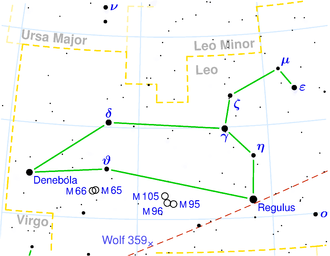NGC 3837
| Galaxie NGC 3837 | |
|---|---|
 | |
| NGC 3837 mit LEDA 1609155 (l)[1] SDSS-Aufnahme | |
| AladinLite | |
| Sternbild | Löwe |
| Position Äquinoktium: J2000.0, Epoche: J2000.0 | |
| Rektaszension | 11h 43m 56,426s[2] |
| Deklination | +19° 53′ 40,48″[2] |
| Erscheinungsbild | |
| Morphologischer Typ | E[2] |
| Helligkeit (visuell) | 13,3 mag[3] |
| Helligkeit (B-Band) | 14,3 mag[3] |
| Winkelausdehnung | 0,8′ × 0,8′[3] |
| Flächenhelligkeit | 12,9 mag/arcmin²[3] |
| Physikalische Daten | |
| Zugehörigkeit | Abell 1367 WBL 353[2] |
| Rotverschiebung | 0.020447 ± 0.000033[2] |
| Radialgeschwindigkeit | 6130 ± 10 km/s[2] |
| Hubbledistanz vrad / H0 | (272 ± 19) · 106 Lj (83,3 ± 5,8) Mpc [2] |
| Geschichte | |
| Entdeckung | William Herschel |
| Entdeckungsdatum | 26. April 1785 |
| Katalogbezeichnungen | |
| NGC 3837 • UGC 6701 • PGC 36476 • CGCG 097-089 • MCG +03-30-068 • 2MASX J11435642+1953403 • GC 2526 • H III 377 • h 961 • GALEXASC J114356.43+195340.0 • LDCE 836 NED018 • WISEA J114356.41+195340.3 | |
NGC 3837 ist eine Elliptische Galaxie vom Hubble-Typ E0[3] im Sternbild Löwe an der Ekliptik. Sie ist schätzungsweise 272 Millionen Lichtjahre von der Milchstraße entfernt und hat einen Durchmesser von etwa 65.000 Lichtjahren. Vermutlich bildet sie gemeinsam mit PGC 1609155 ein gravitativ gebundenes Galaxienpaar. Sie gilt als Mitglied des Leo-Galaxienhaufens Abell 1367.
Im selben Himmelsareal befinden sich u. a. die Galaxien NGC 3841, NGC 3842, NGC 3845, NGC 3851.
Das Objekt wurde am 26. April 1785 vom deutsch-britischen Astronomen William Herschel entdeckt.[4]
Weblinks
Einzelnachweise
Auf dieser Seite verwendete Medien
Autor/Urheber: Copyright © 2003 Torsten Bronger., Lizenz: CC BY-SA 3.0
This is a celestial map of the constellation Leo, the Lion.
Autor/Urheber: Sloan Digital Sky Survey, Lizenz: CC BY 4.0
The sky image is obtained by Sloan Digital Sky Survey, DR14 with SciServer.
Angle of view: 4' × 4' (0.3" per pixel), north is up.
Details on the image processing pipeline: https://www.sdss.org/dr14/imaging/jpg-images-on-skyserver/



